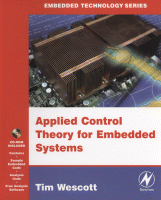Browse content
Table of contents
Actions for selected chapters
- Full text access
- Book chapterAbstract only
1 - The Basics
Pages 1-9 - Book chapterAbstract only
2 - Z Transforms
Pages 11-41 - Book chapterAbstract only
3 - Performance
Pages 43-63 - Book chapterAbstract only
4 - Block Diagrams
Pages 65-93 - Book chapterAbstract only
5 - Analysis
Pages 95-124 - Book chapterAbstract only
6 - Design
Pages 125-148 - Book chapterAbstract only
7 - Sampling Theory
Pages 149-182 - Book chapterAbstract only
8 - Nonlinear Systems
Pages 183-224 - Book chapterAbstract only
9 - Measuring Frequency Response
Pages 225-245 - Book chapterAbstract only
10 - Software Implications
Pages 247-292 - Book chapterAbstract only
11 - Afterword
Pages 293-296 - Book chapterNo access
About the Author
Page 297 - Book chapterNo access
Index
Pages 299-303
About the book
Description
Many embedded engineers and programmers who need to implement basic process or motion control as part of a product design do not have formal training or experience in control system theory. Although some projects require advanced and very sophisticated control systems expertise, the majority of embedded control problems can be solved without resorting to heavy math and complicated control theory. However, existing texts on the subject are highly mathematical and theoretical and do not offer practical examples for embedded designers. This book is different;it presents mathematical background with sufficient rigor for an engineering text, but it concentrates on providing practical application examples that can be used to design working systems, without needing to fully understand the math and high-level theory operating behind the scenes. The author, an engineer with many years of experience in the application of control system theory to embedded designs, offers a concise presentation of the basics of control theory as it pertains to an embedded environment.
Many embedded engineers and programmers who need to implement basic process or motion control as part of a product design do not have formal training or experience in control system theory. Although some projects require advanced and very sophisticated control systems expertise, the majority of embedded control problems can be solved without resorting to heavy math and complicated control theory. However, existing texts on the subject are highly mathematical and theoretical and do not offer practical examples for embedded designers. This book is different;it presents mathematical background with sufficient rigor for an engineering text, but it concentrates on providing practical application examples that can be used to design working systems, without needing to fully understand the math and high-level theory operating behind the scenes. The author, an engineer with many years of experience in the application of control system theory to embedded designs, offers a concise presentation of the basics of control theory as it pertains to an embedded environment.
Key Features
- Practical, down-to-earth guide teaches engineers to apply practical control theorems without needing to employ rigorous math
- Covers the latest concepts in control systems with embedded digital controllers
- Practical, down-to-earth guide teaches engineers to apply practical control theorems without needing to employ rigorous math
- Covers the latest concepts in control systems with embedded digital controllers
Details
ISBN
978-0-7506-7839-1
Language
English
Published
2006
Copyright
Copyright © 2006 Elsevier Inc. All rights reserved
Imprint
Newnes
